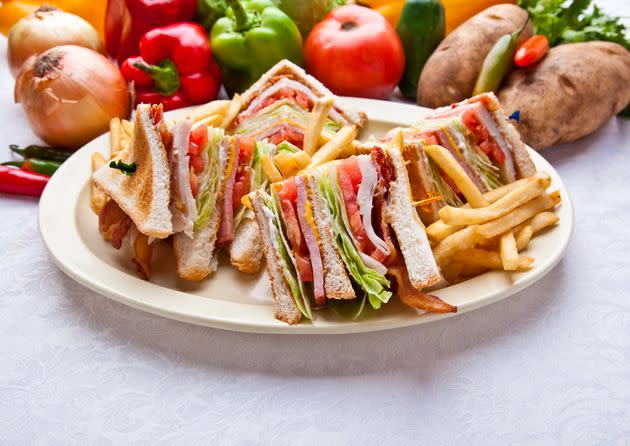Eliminating These 3 Foods From Your Diet Can Be A Game-Changer For Heart Health

Hint: All three foods are shown in this photo.
Heart disease is the leading cause of death in the United States. People of most racial and ethnic groups in the country are more likely to die from a heart-related issue than anything else.
These statistics are startling, and if you’ve ever felt overwhelmed when researching what you can do to improve your heart health, you’re not alone. The good news? You don’t have to exercise for three hours a day and eat a diet entirely of fish and plant-based foods to keep your heart healthy. A few simple tweaks can go a long way.
One of the easiest things you can do is to eliminate (or strictly limit) certain foods that are especially hard on your heart. Here, cardiologists and a nutritionist discuss three foods that you should consider cutting from your diet ASAP, and what to eat instead.
Bacon
Sorry, bacon enthusiasts, but all the experts we consulted agreed: If you want to take good care of your heart, you should save bacon for special occasions or eliminate it from your diet completely.
“The way bacon is made can lead to adverse effects on heart health,” said Michelle Routhenstein, a preventive cardiology dietitian-nutritionist.
“The curing process of bacon with sodium nitrite and its high sodium content can elevate blood pressure, while the compounds formed during cooking, like polycyclic aromatic hydrocarbons and heterocyclic amines (HCAs), contribute to inflammation and damage to blood vessels, collectively increasing the risk of heart disease.”
While bacon is the greatest offender, Dr. Saman Setareh-Shenas, a cardiologist at Cedars-Sinai, said that anyone who is eating with heart health in mind should be wary of processed meats in general, as well as red meats. (Although often considered white meat by culinary standards, pork is classified by Cleveland Clinic, Diabetes UK and other entities as red meat.)
“People who eat diets rich in red meat, especially those with highly processed meats, have been associated with higher cardiovascular disease incidence and mortality, and obesity,” Setareh-Shenas said. “Ingredients used to make these foods include sodium and nitrites. Bacon is especially high in salt, saturated fat, cholesterol, heme iron, polycyclic aromatic hydrocarbons, and heterocyclic amines.”
White Bread
White bread — think Wonder Bread products, or similar white breads you might find in a bag at the grocery store — can be very bad for your heart, according to Routhenstein.
“White bread, with its high glycemic index and lack of nutrients and fiber compared to whole-grain options, can lead to rapid blood sugar spikes, insulin resistance and weight gain, all of which increase the risk of heart disease and related complications,” she said.
Dr. Daniel Luger, a preventive cardiologist at Rush University Medical Center in Chicago, echoed this.
“All refined carbohydrates increase your circulating glucose and triglyceride levels,” he said. “White bread is stripped of all of the healthy fiber and nutrients. What’s left is pure sugar.”
If you’re wondering whether the baguettes that were made in your grocery store’s bakery department are any healthier than a bag of white Wonder Bread, you can take some cues from the ingredients label. Luger suggested looking for a “100% whole-grain” stamp on the package, as well as carefully reading the list of ingredients.
“When looking at the ingredient list, you want to see the first ingredient being listed as whole (whole wheat, whole grain, etc.),” he said. “Ideally, when looking at the ingredient list you want to see only a handful of ingredients, and be able to recognize what those ingredients are.”
French Fries
In especially devastating news, french fries aren’t doing your heart any favors.
“When food is fried, its nutritional content changes — the food loses water and takes up fat,” Setareh-Shenas explained. “Especially in the case of french fries, the oil is often reused, which leads to a loss of unsaturated fats and an increase in trans fats. French fries are also topped with lots of salt, and high sodium intake has been associated with high blood pressure and an increase in heart disease.”
The regular consumption of fried food in general, he added, has been linked to an increase in coronary heart disease, high blood pressure and obesity.
What Should You Eat Instead?
You know what you shouldn’t be eating. But which foods can improve heart health?
“I highly recommend increased consumption of legumes like lentils, chickpeas and beans,” Luger said. “Legumes are high in healthy fiber and help promote satiety, regulate bowel movements and feed healthy gut bacteria. Also, legumes can easily be made in bulk and are great for weekday meals.”
If you’re able to squeeze flaxseeds and almonds into your diet, Routhenstein recommended doing that.
“These foods contain lignans, which have antioxidant and anti-inflammatory properties that support heart health by reducing oxidative stress and inflammation,” she said. “These compounds, alongside other nutrients such as vitamin E, alpha-linolenic acid and magnesium, contribute to improved cholesterol levels, blood pressure regulation and vascular health, collectively offering cardioprotective benefits.”
When it comes to grains,choosing the right ones is key, according to Routhenstein.
“Quinoa and whole-wheat bread are heart-healthy choices due to their rich nutrient profile, including fiber, phosphorus, zinc, plant-based protein and antioxidants, which collectively lower LDL cholesterol and reduce the risk of heart disease,” she said. “Their high fiber content regulates blood sugar levels and supports a healthy gut, contributing to overall heart health.”
Keeping your heart healthy is a lifelong journey, and diet is only part of the picture. Routhenstein, Luger and Setareh-Shenas all emphasized the importance of regular exercise and avoiding habits like smoking. But skipping the bacon, white bread and french fries whenever possible is a great place to start.

 Yahoo News
Yahoo News 